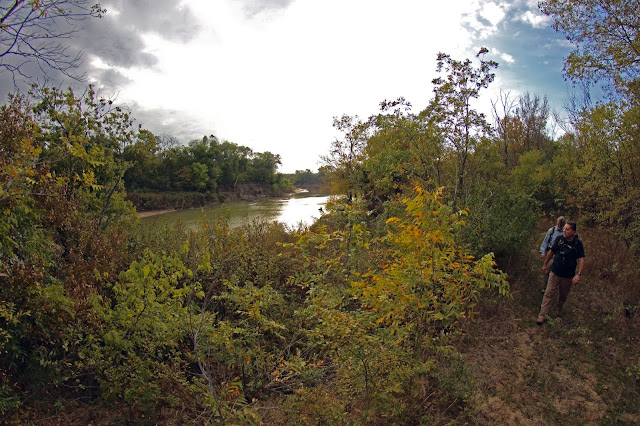Riverbend Preserve — 100th Anniversary of Trinity River Lock and Dam #4
The howling obscenities of coyotes are some of the only sounds heard at this distant place. Far removed from the modern world, exploring this part of the Trinity in Dallas County shows the river in the raw. Waterfowl and deer abound here in great numbers. The haunting hoot of Barred Owls are a constant companion. It has always been this way here, a place early pioneers feared enough that they dare not venture. The old settlers called the place Bois d’ Arc Island, Parson’s Slough or Old Hickory Slough. Today they call it the Trinity River Greenbelt Riverbend Preserve. An ill marked patchwork of land that’s hard to navigate and even harder to judge where public land stops and private land begins.
Stars still hang above the place as we step off the pavement and into the bottoms here. The horizon’s pale blue stain of a new day on the sky begins to expand into the night sky yielding a fire of red hues and pinks to the clouds. Red sky in the morning, sailors take warning. The approach of a Norther signaled a dramatic change of weather in the morning hours. One that put the sky into disarray, a brief sprinkle or two and ever changing cloud cover that yielded some stunning peeks of a rising sun.
Riverbend Preserve
| Trailhead sign on Bois d’ Arc Island, Bois d’ Arc road |
The Trinity River Greenbelt is labeled on maps is a patchwork of properties known as Riverbend Preserve in Southern Dallas County.
Bisected by Malloy Bridge Road, the property is around 520 acres in size and the largest Dallas County nature preserve in the county’s preserve system. More information on the Dallas County website here
http://www.dallascounty.org/department/plandev/locations/11-river-bend.php
Getting there is not hard. A straight shot down I-45 or US 175 from Dallas, take the Malloy Bridge Road exit till you get to the large Malloy Bridge over the Trinity River. Simple enough. But where from there? Signs near the bridge at either end note “no parking” yet there are prominent signs noting the preserve. Better park somewhere else.
 One trailhead exists south of Malloy Bridge Road on Bois d’ Arc Road in about the 200 block and can be found 200-300 Bois d’ Arc Road Combine Texas. No parking lot exists, wide spot or really anywhere in particular that looks good to leave a vehicle unattended.
One trailhead exists south of Malloy Bridge Road on Bois d’ Arc Road in about the 200 block and can be found 200-300 Bois d’ Arc Road Combine Texas. No parking lot exists, wide spot or really anywhere in particular that looks good to leave a vehicle unattended.
Quite a bit of planning and homework is required to wander down here. The strange property lines and unmarked notations of where county property ends and private property begins can be problematic. Consulting the Dallas County Appraisal District website http://dcadmaps.dallascad.org/website/dcad/viewer.htm sheds light on who owns what to some degree and should serve as a primer to making contacts with property owners if needed.
The remoteness of such a place and with rarely a human visitor presents the problem of vaguely defined property lines where public lands end and private begins. Our trip covered quite a bit of private property to reach Lock and Dam #4. We were afforded permission by the landowner’s manager and the walk-in would have been impossible otherwise.
 |
| Bill Holston walking a top the near 100 year old levee with borrow pit ponds turned swamp seen in the background beyond |
The hike on either side of Malloy Bridge starts with a walk on the old levees built butting the river. The richest farming bottomland in the whole of Dallas County sits here. Beginning in the early 1900s levees were built and later improved upon in a series of county bonds, state projects and federal funding. 1917 saw the most work here as levee district number 2 was authorized to rework the mouth of Ten Mile Creek and incorporate levees into the land. It has always been a gambler’s game growing crops down here. In wet years when crops grow in abundance elsewhere, the crops here are waterlogged and drowned. The bumper crops and years for great profit come here when the upland fields are withering in the heat and lack of rain.
 |
| On the levee looking down into the acres and acres of ponds |
The old levees today most likely still perform the job they were originally designed to provide. Protection from all but the very worst flooding that the Trinity River can dish out. These levees are about half the height of the Downtown Dallas levees and hold back the seasonal and annual floods of the Trinity from ravaging the Ten Mile Creek, Wolf Springs and Combine areas of Southern Dallas County.
 |
| Mallards in the morning sky |
The levees were constructed using soil piled up and “borrowed” from nearby, creating depressions in the area surrounding the levees. The “borrow pits” as they are known have slowly morphed into pocket pond habitat that supports a variety of wildlife.
 |
| Male Wood Duck |
The early morning sun brought to light many Wood Ducks, as many as any of the party has ever seen in one place. These old borrow pits hold standing live and dead timber, islands of grass and weeds, tangles of brush, patches of aquatic plants, and plenty of dragonflies and damselflies. Surrounded by extensive stands of mature, acorn-bearing oaks, this wetland is ideal wood duck habitat.
Much of the northern half of this area called Bois d’ Arc island was cleared for farming in the early part of the twentieth century. It sits 350 feet above sea level and the lowest part of the county. In the distance one can see broad rolling hills and the expansive bottoms of black waxy soil. Closer to the present day river channel, the land is cut through by numerous creeks and sloughs the more notable being Parson’s Slough to the east and Gravel Slough to the west.
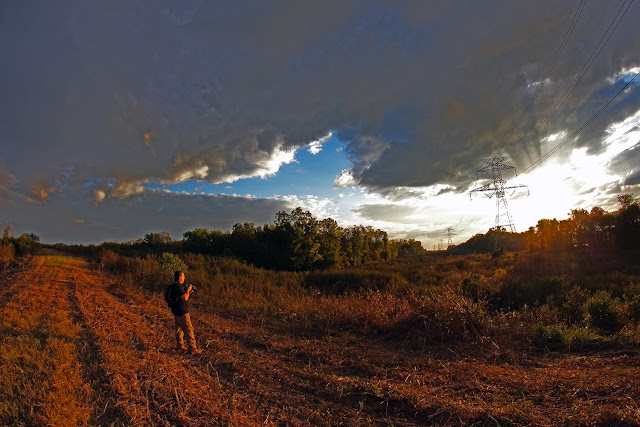 |
| Near the mouth of Ten Mile Creek and the Trinity River approaching Lock and Dam #4 |
The first settlers to this area were drawn by stories of the fertile lands, open range country and plentiful wild game. They were told that the land could be farmed so easily, that in a whole days of plowing one would not strike a stump, which were the constant enemy of cultivating in the southeastern states.
 |
| Hiking through the late season dense flowering Solidago plants also known as Goldenrod |
 |
| JH Woods Land Grant |
The original grantees to the land when Texas was her own Republic read straight from the Muster Rolls of the Republic of Texas Army. JB Grice was in the Fourth Company, Second Regiment Texas Volunteers and veteran of the Battle of San Jacinto. All the photos above are on the original land deeded to him for his service. All the photos below were taken on land originally granted to JH Wood 1st Regiment, Southwestern Army who was a veteran of the Somervell Expedition of 1842.
The war veterans often sold their lands, swapped or traded it with others. Land rich and money poor, the lure of trading off a piece of acreage for something else was very attractive to many. The land sat idle for years until word got out about the rich soils in this part of North Texas. Early pioneers found that they could buy the land, plant cotton and often outright payoff the note for the land with the first harvest.
 |
| Under a massive canopy of mature pecan trees and in an ocean of Roughleaf Dogwoods |
 |
| Endless acres of 10′ high dogwood in the bottoms |
All the water that fell from the heavens was absorbed on the vast lands by the grasses and natural growth. Underground water tables were high and fed many springs in the area. Back then there was no washed-away soil, depleting the richness of the land. A time before those same soils began eroding, filling the waterways with silt so that they could never be navigated.
The problem for these first farmers and the ever expanding second wave behind them were bringing the fruits of their labor to market. The cotton exchanges of Galveston and Louisiana were many hundreds of miles away before the Civil War and North Texas might just as well have been on the Moon when it came to the difficulty of cashing in on their crops.
A Brief Primer On Trinity Navigation
 |
| Stock Certificate for Trinity River Navigation Company |
The Trinity River was the first artery of commerce to open on which merchandise and man was transported into Central and North Texas. The first official mention of a navigable Trinity River was made in 1853 by Colonel Whiting, an army engineer, who in a report informed President Franklin Pierce, that the Trinity River “was the deepest and the least obstructed river in Texas”. That most likely is entirely true. Knee deep in many spots, the Trinity takes first place over the shin deep Brazos and ankle deep Colorado. Famous last words. He recommended that the government take steps to develop this waterway.
In Pre-Civil War Dallas County, oxen teams formed the backbone of long haul transportation between other settlements to the south and to the east. Limited by the amount of cargo they could carry and the seemingly turtle like speed of an oxen drawn wagon, Dallas County would have to wait until after the Civil War and even after the draconian Reconstruction era to see transportation improvements.
Dallas County never had effective river transportation, but community leaders had tried several times, beginning in the 1840s, to get Congress to provide federal funds for the improvement of the Trinity River. The northern navigable limits of barge operations on the Trinity River were in the Porter’s Bluff area near present day Trinidad. On old maps labeled as Taos, Texas, this spot sits near the geographic boundaries of present day Ellis, Navarro and Henderson Counties.
 |
| First lock and dam at McCommas Bluff circa 1893 |
By 1890, Dallas had rail service for almost twenty years, time enough for Dallas residents to see the oft-repeated practice of railroads lowering their freight rates to drive river transportation out of business, then raising the rates again. When the price of shipping a bale of cotton from Dallas to Houston on the H&TC railroad increased from a dollar per bale in the 1870s to nearly three dollars per bale in the 1880s, Dallasites became concerned. Especially when the price of cotton began to decline in the 1890s, Dallas business leaders were sufficiently concerned to renew their efforts to open the Trinity to navigation.
In the summer of 1891, civic leaders formed the Trinity River Navigation and Improvement Company to raise money for a renewed effort to get Congress to appropriate money for the river’s improvement. In 1892 Dallas leaders purchased the 65′ Snag Boat Dallas to clear the river of rafted debris and snags. They soon added a large steamboat, the H. A. Harvey.
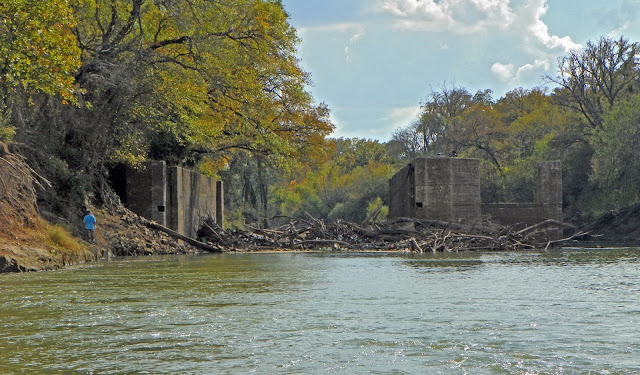 |
| Lock and Dam #1 at McCommas Bluff looking downstream |
In 1899 Congress authorized another survey of the river by the United States Army Corps of Engineers. In 1902 with an appropriation of $400,000, the federal government over the next twenty years spent more than $2,000,000 building locks and dams on the Trinity. The First World War halted this work and in 1920 the project was abandoned as too cost prohibitive.
The original federal plans called for 36 locks and dams along the Trinity River from Trinity Bay to Dallas. The work was never fully completed and only locks 1, 2, 4, 6, 7, 20, and 25 were ever built. The Dallas County projects were Lock 1 at McCommas Bluff, Lock 2 near present day Beltline Road and Lock 4 two miles south of Malloy Bridge Road.
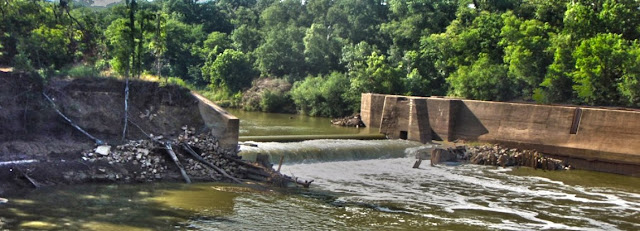 |
| Lock and Dam #2 at Goat Island Preserve |
Lock and Dam Number #1 at McCommas Bluff probably has the most hardware and gates still intact. Moving downstream Lock and Dam # 2 has been a favored fishing spot by Southern Dallas County locals for many decades, over time the wooden gates and hardware have either been burned for campfires or drifted away by flood water.
Lock and Dam #2 sits just dowstream of the old Parson’s Slough, the old river channel that once carried waters of the river to a large degree and created Bois d’ Arc Island. In 1911, the slough was permanently cutoff from the Trinity River near Goat Island Preserve just north of present day Beltline Road. The same construction company that built Lock and Dam Number 2, built a concrete dam at the head of Parson’s Slough where it meets the Trinity. Twenty feet high and two hundred feet wide, the goal was to permanently send the river down the new channel rather than risk a flood putting the river meander back in the old.
The city’s love affair with dams on the Trinity continues to this day with a whitewater kayak/canoe feature at the old ATSF Train Trestle just downstream of the Corinth Street Bridge in Downtown Dallas.
Lock and Dam #4
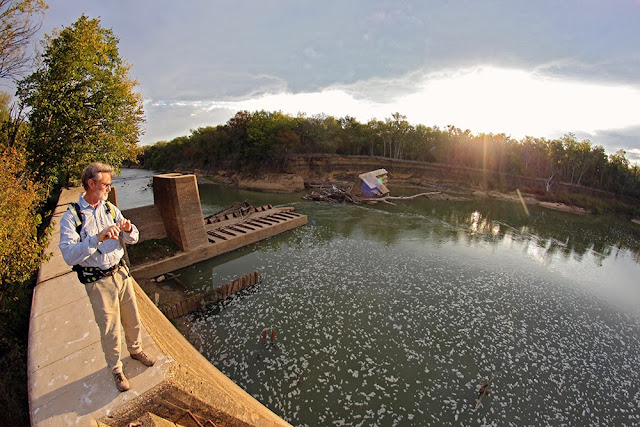 |
| Lock and Dam 4 in Dallas County Texas |
The least visited of all Lock and Dams on the Trinity River is number 4. Miles from the nearest road of any kind, across steep ravines, tanglefoot brush and large stands of mature hardwoods you find it.
 The ever expanding roads and rails of Texas caught up to this place, mothballing a riverine method of transportation from Dallas to the Gulf. One could argue what put the mortal wound on the lock and dam here, was it the magnitude of transportation improvements by train or truck. Maybe it was the fickle nature of the river itself. A placid piece of shallow water much of the year interrupted by biblical floods that wrecked anything man ever touched on the banks.
The ever expanding roads and rails of Texas caught up to this place, mothballing a riverine method of transportation from Dallas to the Gulf. One could argue what put the mortal wound on the lock and dam here, was it the magnitude of transportation improvements by train or truck. Maybe it was the fickle nature of the river itself. A placid piece of shallow water much of the year interrupted by biblical floods that wrecked anything man ever touched on the banks.
The lock is now not much more than a favored roost for vultures. A really long forgotten spot on the Trinity, one whose time came and went in the blink of an eye. It stands as testament to a folly of ill conceived grand ideas for turning the Trinity into something it could never be.
 |
| Climbing down the steel ladder into the silt filled lock box of the lock and dam |
The approach to Lock and Dam #4 is aided by the long ago silted in lock box that once allowed boats to be lifted and lowered by manipulation of the water level. Above in the photo, all but 5-6 of the original 2 dozen or so rungs of a concrete fixed steel ladder are visible. The rest of the rungs sit many feet under years of flood silt.
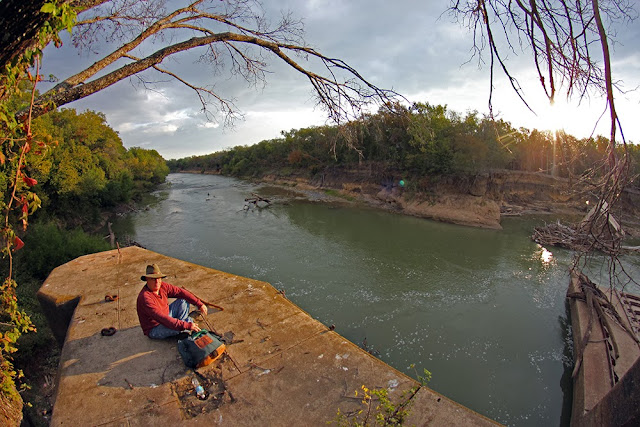 |
| Looking upstream and a top the buttress separating the lock box channel from the former floodgates |
 |
|
| Trinity River Lock and Dam #1 rendering |
The principle behind locks is straightforward: The river is an inclined plane whose water moves in and out of locks by gravity. Think of locks as a flight of “water stairs” going up and down a hill. Water is drained from the first lock (using gravity) until the water level is even with the second one. The downstream gate is opened so the vessel can move into the lower lock, and the process would need to be repeated numerous times in Dallas County.
 |
| Remains of the floodgate system and east bank in the background, note the toppled over concrete foundation in the background |
During times of high water, the floodgate system could be moved from vertical to horizontal, allowing for water and debris to pass easily over the structure. The floodgates themselves were steel in construction with replaceable wooden timbers forming the spaces in between.
As one can see above, the Trinity has worked her power on the east section of the lock and dam. It has cartwheeled the east foundation of the lock. As a result through flooding, the river has started to alarmingly erode a large section of the east bank. It has created a large basin around the structure. I believe the Trinity River Authority is studying the problem and is looking into solutions to fix it..
Some of the wooden pilings and piers for the facility can still be seen today. The construction of lock and dam #4 started in 1910 and was completed in 1913. It went into operation in the summer of 1913 and as such sees the 100th anniversary of completion this year in 2013.
 It is unknown how many boats ever navigated through the lock here. How many ever moored to the small docks or saw the pulley systems drag the boat into the lock channel.
It is unknown how many boats ever navigated through the lock here. How many ever moored to the small docks or saw the pulley systems drag the boat into the lock channel.
Maybe it’s not the 100th year of such a place like this is not that important. Might be that seeing how well it was built, how well the concrete was poured and how sturdy most of the structure stands will see it through the next 100 years looking the same as it does today.
 |
| Lock and Dam #4 looking downstream, mouth of Ten Mile Creek in far distance |
Downstream of Lock and Dam #4 one can really get a clear view of the water forces at work that have eroded the banks to some extent.
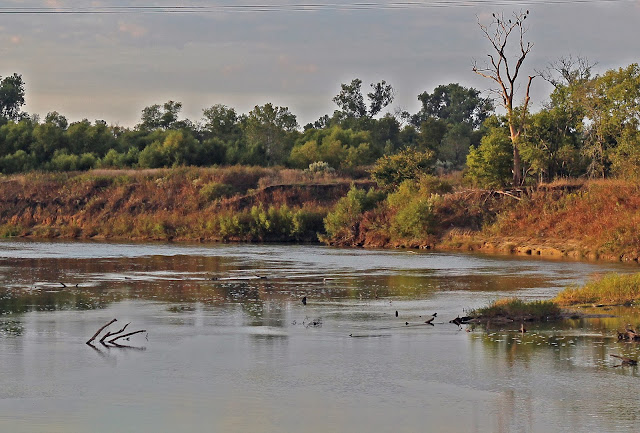 |
| Mouth of Ten Mile Creek just beyond the dead tree with vultures in the limbs |
The current mouth of Ten Mile Creek is an artificially constructed sluice of sorts that features a re-routed section of Ten Mile from the town of Ferris at I-45 to the Trinity. Known as South Creek, it runs through one of the finest cattle ranches in Texas, known as the South Creek Ranch. Famed for their easy to spot longhorn orange buildings and fenceposts, the acreage of the ranch commands some 6,000+ acres in Dallas County.
 |
| Old route of Ten Mile Creek in Dallas County |
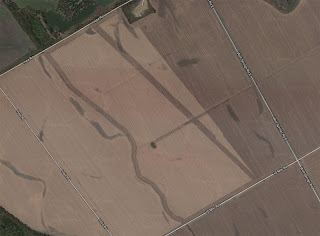 |
| Old Ten Mile Creek meander |
The old route of Ten Mile Creek is easy to spot in aerial photos and is widely noted on many maps. The historic channel of the creek headed due south and into Ellis County before adjoining the Trinity River. Certain times of year after the cotton fields are plowed one can still see the old creek meanders.
The creek was rerouted in the 1910s as part of the levee reclamation project that turned much of the floodplain into usable farmland.
 |
| The concrete building at Lock and Dam #4 |
 In the vicinity of Lock and Dam #4 is a slab poured concrete building that served as a storeroom, warehouse and makeshift lockkeepers office for the dam.
In the vicinity of Lock and Dam #4 is a slab poured concrete building that served as a storeroom, warehouse and makeshift lockkeepers office for the dam.
The same age as the dam itself, the building has seen the same ravages of flood and time as the lock and dam just a couple hundred feet away.
It sits up from the river some distance, in a first generation set of woods populated by ash, hackberry and a sprinkle of hickory and pecan here and there.
 The building now lacks a roof, most likely it was tin metal of some kind and long lost to scavengers.
The building now lacks a roof, most likely it was tin metal of some kind and long lost to scavengers.
The construction suggests that it was poured in forms here and from the looks of things uses the same twisted rebar as used in the lock and dam nearby. Evidence is seen in the lone window frame that looks west from the building.
The door frames here have sliding brackets to them which suggest that the doors were large single storeroom doors that could move large material in and out of the building with ease.
No electrical lines, telephone lines or infrastucture in the building or nearby suggests it held supplies for supporting the lock and dam.
A hackberry grows through the floor on the north end which leads out through a second door of similar construction to that of the southern entrance.
For a 100 year old building it’s rock solid and ready for 100 more.
Feral Pigs at Riverbend Preserve
 |
| Feral Pig Sounder near Lock and Dam #4 |
Feral pigs are a constant companion for hikers and bikers on the Trinity River. Riverbend Preserve is no exception. In the photos is a feral pig sounder or family group of pigs that are rooting along the old levee. Not much of a care in the world when they are with the family group.
These pigs ranged in size well about 75-100 pounds and are immune to depredation by natural predator species like coyotes, bobcats or loose dogs. Other than a bullet or the front bumper of a car they have very little to fear and they know it. We observed the pigs here for a few minutes until they noticed us, then they slowly walked away and melted into the brush.
Give them space, make a little noise and they will always drift away. We did see a larger solitary boar, at least twice the size of the others, rooting in a field of ragweed. It was faster to leave the area the second it caught wind of us.
 |
| A view of Bois d’ Arc Island from across the river |
Beyond the levee and closer to the Trinity River, loose game trails and faint paths are all that exists to guide one through the woods here. The snaking river, really gives the place it’s namesake, Riverbend.
The grand U shaped curves are something not seen in the city limits of Dallas. The towering trees on either side, large sand bars and banks command the views at every turn.
| Shell lens and fire cracked rock scattered in the eroding bank |
One such bend sits above a spot where Hickory Creek once entered the Trinity. Hickory Creek’s watershed drains through Sunnyvale, Seagoville and heads southwest towards the Trinity River. Much like Ten Mile Creek it was moved to some extent and channelized leaving the historic mouth of the creek in mothballs.
Here on the opposing bank of the old mouth, is evidence of pre-historic man. Not sure if the vernacular is right on calling those Ancient Texans pre-historic maybe pre-Columbian is the term to use. Here eroding out of the bank are old charcoal deposits, fire cracked rock pieces, old mussel shells and animal bone left behind by some epic Indian cookout on the bank.
| Animal bone and charcoal scattered in the eroding Trinity River bank |
It’s not hard to imagine that the Trinity here ever looked any different then as it looks today. Wild as it ever was and most likely forever will be.












